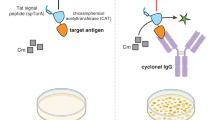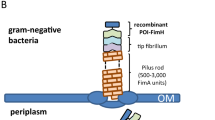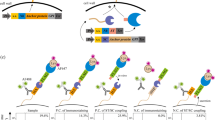Abstract
We have developed a system for probing protein/protein interactions which makes use of the bacterial flagellum to display random peptide libraries on the surface of E. coli. In developing the system the entire coding sequence of E. coli thioredoxin (trxA) was inserted into a dispensable region of the gene for flagellin (fliC), the major structural component of the E. coli flagellum. The resulting fusion protein (FLITRX) was efficiently exported and assembled into partially functional flagella on the bacterial cell surface. A diverse library of random dodecapeptides were displayed in FLITRX on the exterior of E. coli as conformationally constrained insertions into the thioredoxin active-site loop, a location known to be a highly permissive site for the insertion of exogenous peptide sequences into native thioredoxin. To demonstrate that members of this library could be bound and selected via specific protein/protein interactions to a target protein, a method was devised to enable efficient isolation of those bacteria displaying peptides with affinity to immobilized antibodies. We have unambiguously mapped three different antibody epitopes using this method. Peptides selected as FLITRX active-site fusions retain their binding specificity when made as native thioredoxin active-site loop fusions. This will facilitate future structural characterizations and broaden the general utility of the system for exploring other classes of protein-protein interactions.
This is a preview of subscription content, access via your institution
Access options
Subscribe to this journal
Receive 12 print issues and online access
$209.00 per year
only $17.42 per issue
Buy this article
- Purchase on Springer Link
- Instant access to full article PDF
Prices may be subject to local taxes which are calculated during checkout
Similar content being viewed by others
References
Smith, G.P. 1985. Filamentaous fusion phage: novel expression vectors that display cloned antigens on the virion surface. Science 228: 1315–1317.
Parmley, S.F. and Smith, G.P. 1988. Antibody-selectable filamentous fd phage vectors: affinity purification of target genes. Gene 73: 305–318.
Scott, J.K. and Craig, L. 1994. Random peptide libraries. Curr. Opin. Biotechnol. 5: 40–48.
Hammer, J., Takacs, B. and Sinigaglia, F. 1992. Identification of a motif for HLA-DR1 binding peptides using M13 display libraries. J. Exp. Med. 176: 1007–1013.
Oldenberg, K.R., Loganathan, D., Goldstein, I.J., Schultz, P.G. and Gallop, M.A. 1992. Peptide ligands for a sugar-binding protein isolated from a random peptide library. Proc. Nat. Acad. Sci. USA 89: 5393–5397.
Scott, J.K., Loganathan, D., Easley, R.B., Gong, X. and Goldstein, I.J. 1992. A family of concanavalin A-binding peptides from a hexapeptide epitope library. Proc. Nat. Acad. Sci. USA 89: 5398–5402.
Blond-Elguindi, S., Cwirla, S.E., Dower, W.J., Lipshutz, R.J., Sprang, S.R., Sambrook, J.F. and Gething, M.-J.H. 1993. Affinity panning a library of peptides displayed on bacteriophage reveals the binding specificity of BiP. Cell 75: 717–728.
Djojonegoro, B.M., Benedik, M.J. and Willson, R.C. 1994. Bacteriophage surface display of an immunoglobulin-binding domain of Staphylococcus aureus protein A. Bio/Technology 12: 169–172.
Katti, S.K., LeMaster, D.M. and Eklund, H. 1990. Crystal structure of thioredoxin from E. coli at 1.68 angstroms resolution. J. Mol. Biol. 212: 167–184.
LaVallie, E.R., Diblasio, E.A., Kovacic, S., Grant, K.L., Schendel, P.F. and McCoy, J.M. 1993. A thioredoxin gene fusion expression system that circumvents inclusion body formation in the E. coli cytoplasm. Bio/Technology 11: 1187–193.
Scott, J.K. and Smith, G.P. 1990. Searching for peptide ligands with an epitope library. Science 249: 386–390.
LaVallie, E.R. and Stahl, M.L. 1989. Cloning of the flagellin gene from Bacillus subtilis and complementation studies of an in vitro-derived deletion mutation. J. Bacteriol. 171: 3085–3094.
Namba, K., Yamashita, I. and Vonderviszt, F. 1989. Structure of the core and central channel of bacterial flagella. Nature 342: 648–654.
Wilson, A.R. and Beveridge, T.J. 1993. Bacterial fiagellar filaments and their component flagellins. Can. J. Microbiol. 39: 451–472.
Kuwajima, G. 1988. Construction of a minimum-size functional flagellin of Escherichia coli. J. Bacteriol. 170: 3305–3309
Joys, T.M. 1988. The flagellar filament protein. Can. J. Microbiol. 34: 452–458.
Diderichsen, B. 1980. flu, a metastable gene controlling surface properties of Escherchia coli. J. Bacteriol. 141: 858–867.
Ofek, I. and Beachy, E.H. 1978. Mannose binding and epithelial cell adherence of Escherichia coli. Infect. Immun. 22: 247–254.
Ponniah, S., Endres, R.O., Hasty, D.L. and Abraham, S.N. 1991. Fragmentation of E. coli type 1 fimbriae exposes cryptic D-mannose-binding sites. J. Bacteriol. 173: 4195–4202.
Clore, G.M., Apella, E., Yamada, M., Matsushima, K. and Gronenborn, A.M. 1990. Three dimensional structure of interleukin 8 in solution. Biochemistry 29: 1689–1696.
Hutchcroft, J.E., Anostario, M.,Jr., Harrison, M.L. and Geahlen, R.L. 1991. Renaturation and assay of protein kinases after electrophoresis in sodium dodecyl sulfate-polyacrylamide gels. Method in Enzymol. 200: 417–423.
Shackelford, D.A. and Zivin, J.A. 1993. Renaturation of calcium/calmodulin-dependent protein kinase activity after electrophoretic transfer from sodium dodecyl sulfate-polyacrylamide gels to membranes. Anal. Biochem. 211: 131–138.
Charbit, A., Molla, A., Saurin, W. and Hofnung, M. 1988. Versatility of a vector for expressing foreign polypeptides at the surface of Gram-negative Bacteria. Gene 70: 181–189.
Brown, S. 1992. Engineered iron oxide-adhesion mutants of the Escherichia coli phage λ receptor. Proc. Natl. Acad. Sci. USA 89: 8651–8655.
Francisco, J.A., Campbell, R., Iverson, B.L. and Georgiou, G. 1993. Production and fluorescence-activated cell sorting of Escherichia coli expressing a functional antibody fragment on the external surface. Proc. Natl. Acad. Sci. USA 90: 10444–10448.
McLafferty, M.A., Kent, R.B., Ladner, R.C. and Markland, W. 1993. M13 bacteriophage displaying disulfide-constrained microproteins. Gene 128: 29–36.
Fedorov, O.V. and Efimov, A.V. 1990. Flagellin as an object for supramolecular engineering. Protein Eng. 3: 411–413.
Jessen, T., Cohen, B., Colas, P., Mendelsohn, A.M., McCoy, J. and Brent, R. 1994. Artificial peptide inhibitors of Cdk2-dependent cell proliferation. Manuscript in preparation.
Holmgren, A. 1985. Thioredoxin. Ann. Rev. Biochem. 54: 237–271.
Wurfel, M., Haberlein, I and Follmann, H. 1993. Facile sulfitolysis of the disulfide bonds in oxidized thioredoxin and glutaredoxin. Eur. J. Biochem. 211: 609–614.
Brent, R. and Ptashne, M. 1981. Mechanism of action of the lex A gene product. Proc. Nat. Acad. Sci. USA 78: 4204–4208.
Blair, D.F., Kim, D.Y. and Berg, H.C. 1991. Mutant MotB proteins in Escherichia coli Bacteriol. 173: 4049–4055.
Norrander, J., Kempe, T. and Messing, J. 1983. Construction of improved M13 vectors using oligonucleotide-directed mutagenesis. Gene 26: 101–106.
Author information
Authors and Affiliations
Rights and permissions
About this article
Cite this article
Lu, Z., Murray, K., Cleave, V. et al. Expression of Thioredoxin Random Peptide Libraries on the Escherichia coli Cell Surface as Functional Fusions to Flagellin: A System Designed for Exploring Protein-Protein Interactions. Nat Biotechnol 13, 366–372 (1995). https://doi.org/10.1038/nbt0495-366
Received:
Accepted:
Issue Date:
DOI: https://doi.org/10.1038/nbt0495-366
This article is cited by
-
Chimeric Peptides as Implant Functionalization Agents for Titanium Alloy Implants with Antimicrobial Properties
JOM (2015)
-
Identification of a novel short peptide seal specific to CD59 and its effect on HeLa cell growth and apoptosis
Cellular Oncology (2012)
-
TMTP1, a novel tumor-homing peptide, specifically targets hematological malignancies and their metastases
Journal of Huazhong University of Science and Technology [Medical Sciences] (2011)



